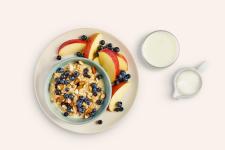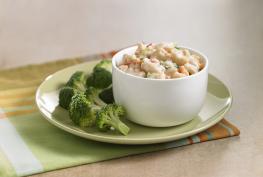Preparing meals and snacks using healthy ingredients can be a way to limit highly processed foods.
On this page
Benefits of preparing meals and snacks using healthy ingredients
Preparing foods at home allows you to make healthier meals and snacks. By choosing ingredients that have little to no added sodium, sugars or saturated fat, you can decrease the amount of these nutrients you eat.
Eating too much sodium, sugars or saturated fat can increase your risk of chronic disease.
How to prepare meals and snacks using healthy ingredients
Even when cooking at home, people may use highly processed foods for convenience and to save time. These types of food products include:
- seasoned foods
- prepared sauces
- ready to eat soups
- ready-made dishes
Make your own versions of these foods or replace them with healthier options.
Do it yourself
Although highly processed foods may seem convenient when cooking at home, making your own can be easy and much healthier. Use these ideas to make healthier homemade versions:
- Try making baked whole grain pita crackers.
- Make your own salad dressing with oils with healthy fats and your favourite seasonings.
- Slice potatoes into thin strips, drizzle with canola oil and bake in the oven for no-fry french fries.
- Use simple recipes. Start with recipes with simple ingredient lists and easy instructions, especially if you are busy or new to cooking.
- Make your own spice mixes. Instead of using packaged taco seasoning, make your own by combining cumin and chili powder with a dash of garlic powder.
- Sweeten snacks and recipes using fruit. Mix lower fat yogurt with berries or use mashed banana in a muffin recipe for added sweetness.
- Make a big batch of homemade soup and freeze it in meal-sized portions. This lets you control the ingredients, and reheating is just as easy as making canned soup.
- Look up a recipe for your favourite sauce or condiment. Make homemade pasta sauce using fresh or low-sodium canned tomatoes. Try making fresh salsa by combining tomatoes, garlic, onion and cilantro.
- Try a homemade version of your favourite prepackaged food. Use a whole grain pizza crust, tortilla or pita and load it with vegetables for a healthier pizza. Make your own macaroni and cheese with whole grain pasta, lower fat cheese and some vegetables.
Add flavour
When you cook at home, you can decrease the amount of salt you use by adding herbs, spices and seasonings. Your taste buds will adjust to less salt in your food.
Instead of using pre-seasoned foods, salt, gravy or sauces, enhance the flavour of your food by adding:
- citrus
- flavoured vinegar
- fresh or dried herbs or spices
Here are a few ideas to get you started:
- dill: pairs well with fish, potatoes and eggs
- cinnamon: tastes great with lower fat yogurt and fruits
- ginger: delicious in stir-fries, soups and with fish
- lemon juice: great in salad dressings and marinades
- paprika: good with seafood, vegetables, chicken and eggs
- rosemary or thyme: delicious with chicken, lamb, beef and pork
- curry powder or cumin: good with lentils, chicken, soup and stews
- basil and oregano: tastes great with soup, salads, tomatoes and pasta
For best results, add:
- dried herbs at the beginning of cooking
- fresh herbs at or near the end of cooking
Use healthier ingredients
When making meals and snacks, use ingredients that are not highly processed.
Let your taste buds enjoy the true flavour of food. Try:
- fresh, frozen or canned vegetables and fruits, preferably:
- canned vegetables with little to no added sodium
- whole grain foods, preferably:
- options with little to no added sodium
- naturally sodium-free grains such as rice, barley or quinoa
- protein foods, preferably:
- unsalted nuts and seeds
- unseasoned meats, poultry and fish
- lower fat dairy products
- canned or dried beans, peas and lentils with little to no added sodium
- healthy fats, preferably:
- unsaturated vegetable oils
Make a healthy choice
What you eat on a regular basis matters for your health.
- Choose foods that have little to no added sodium, sugars or saturated fat.
- Compare the nutrition facts table on foods to choose products that are lower in sodium, sugars or saturated fat.
- Date modified:


